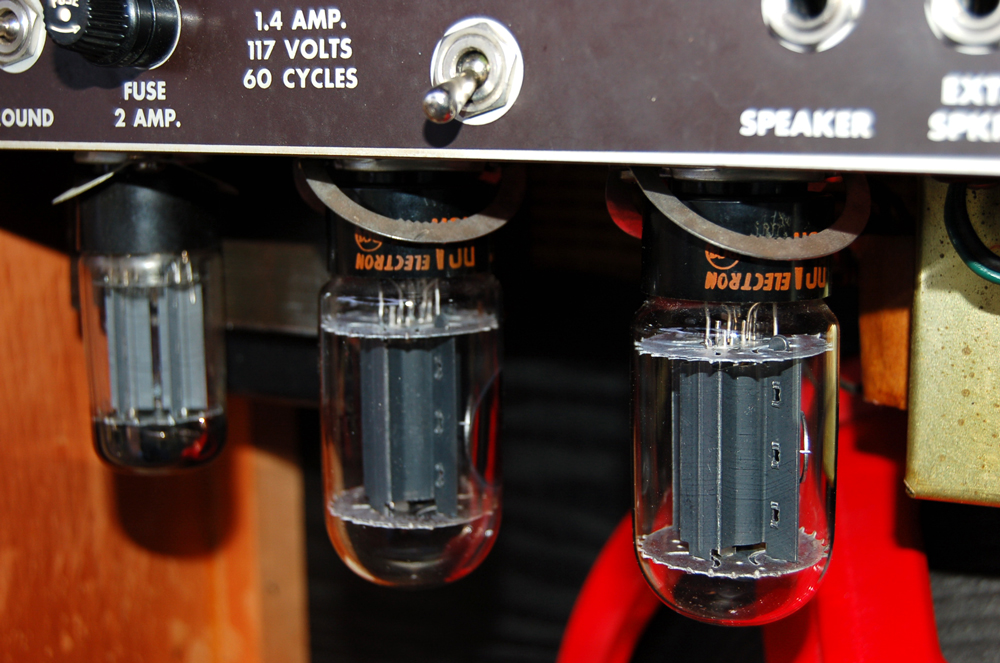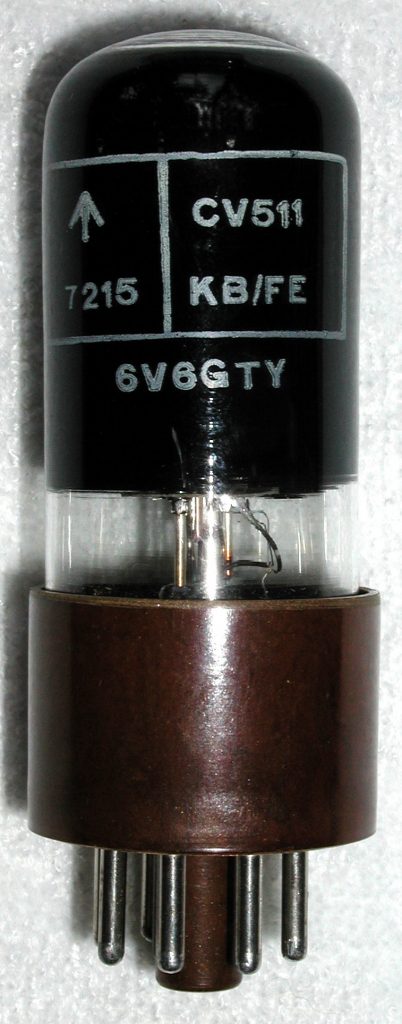The difference in the quality of sound between modern output and preamp tubes and their classic equivalents in direct A/B tests is usually depressing. No contest. For touring pros, burning up rare old tubes really isn’t an option, but for those of us craving tone with a lighter workload, we can still selectively find stellar vintage tubes at less than onerous prices. After we acquired the ‘74 Princeton, we trolled eBay for 6V6s to replace the JJs, and in minutes we had located two pairs of vintage RCA 6V6GTs— 3 NOS and 1 slightly used but testing new (ANOS) and all four were matched with a Maxi Matcher drawing 20.6Ma, 20.6Ma, 21.5Ma, 21.8Ma under load. That’s good. And we paid a very fair $84.65 for the quad, while also getting to know the seller, Dave Baldwin in Seattle— a very helpful and knowledgeable tube hound. No doubt some of the magic we have described in the Princeton can be attributed to the RCA 6V6GTs and the RCA and Sylvania preamp tubes that remain in our stash. These old tubes simply push the sound of your guitar and amp into full audio Technicolor, and we urge you to consider acquiring your own selection of classic tubes while you can. To help you in that endeavor, we asked Dave to provide some information and tips on buying classic vacuum tubes…
Dave Baldwin on NOS Tubes

I grew up listening to classic rock in the 1970s, and early hand-wired amps running vintage glass have an undeniable magic. I play guitar and listening to good guitar tone is a great experience that has helped me upgrade many guitar amps for Seattle area musicians and studios.
Seven years ago I realized my amps sounded better with vintage tubes. I got lucky and bought nine full tube caddies along with a Jackson 648S emissions tester. I like the Jackson because it has a life test that indicates how much a tube has been used. The life test strains the cathode and by seeing how fast and how far the needle drops you can judge the remaining life. The Jackson is lightweight and matched what my Hickok 534 mutual conductance tester was reading.
Large military contracts enabled early manufacturers to R&D to the best of their ability. They used high grade metals, coatings, and critical parts. Who knows if the current EPA would even allow the types of chemicals they used? All the vintage producers took pride in their work and competition was fierce. In my experience vintage tubes offer better clarity, warmth, smoothness, and bandwidth than new production and tend to be robust with a longer lifespan. Vintage preamp tubes offer the biggest improvement in tone and I would suggest starting there first. Current production 12AX7s have been described as glassy, bright, and sterile. I agree. With the exception of the JJECC803 most new 12AX7 plates are very short which can give a feeling of stiffness and compression. Most new production 12AX7s have less than half the metal of a vintage long plate. Mass is good in electronics.


Current production JJEL84, JJKT77, and Sovtek 5881/6L6WGC among others are good sounding output tubes for the working musician when paired with vintage preamp tubes. In fact, surprisingly, I liked the JJEL84 over several vintage brands. Vintage tubes all sound slightly different and knowing the variables can help dial in an amp for recording, live use, and specific styles of music. Humbuckers or single coils? Early breakup or high headroom? 3D and open or compressed?
The earliest 6V6G types produced from 1937 sound slightly more open, clear, and 3D than later GT types. These traits are also true for vintage 12AX7 long plates. Neil Young uses the 6V6G type in his outboard reverb and in his Deluxe he rebiased the amp to run 6L6s. If your amp has the space to run these larger 6V6G types they are certainly worth the cost. If you have an amp that doesn’t draw super high voltage and requires a 6L6GC, the early 6L6G, GA, GB can be amazing choices. These are rated at 360 volts but due to the construction are okay running a little higher if biased correctly. RCA, GE, Sylvania, and Tung-Sol are among the top US vintage output tubes. If you get lucky and find rare National Union 6L6GAs buy them. They are very warm and Mullard like and sound amazing in guitar amps.

Generally RCA blackplate gray glass 6V6GT and TungSol black glass 6V6GTs will have a nice warm creamy and smooth sound similar to European tubes. While recording and at low to moderate levels these are a good choice. In the right amp loud they are great too. Sylvania, Ken-Rad, CBS-Hytron are excellent choices especially when playing loud. Where RCA might start to compress too much and lose definition these later three brands shine the harder they are pushed. Sylvania and Ken-Rad have excellent clarity and chime. Raytheon 6V6GT have the highest headroom of all due to the large robust plates.
What are the pitfalls of buying vintage tubes? Know your seller. Used ANOS vintage tubes are okay if screened properly. They must be tested for emissions or mutual conductance, shorts, and life. When testing a tube the faster the needle goes up the better. If you don’t have a tester, here are some things to look for:
Does it have a dark burn in spot on the glass? Does it have heavy coffee colored staining on the bottom glass? How much of the silver flashing is remaining on top? Do the pins or base have clamp marks? How much dust is between the glass and base? I would avoid sellers who do not have a return policy. Just because a seller has a box does not make a tube NOS. Old techs back in the day were notorious for putting used tubes back in the box. NOS are generally pristine with clean shiny glass, full silver flashing, no burn marks, perfect bases, and have most of the original print intact.

Strong tubes that test in the NOS range are important for guitarists. A strong tube will react faster to your input which is what you need. A tired tube reacts slower and will not have the snap tubes you might expect. Tired tubes also tend to gradually lose the high end. Output tube matching is critical. Properly matched tubes put less strain on the amplifier, run cooler, last longer, and have less crossover distortion. A seller that has matched output tubes in a Maxi-Matcher at 400 volts or a real tube amp is who you want to buy from. They should be able to state the mA draw and the closer the better. Under 5mA apart is good but under 2mA is even better and you need to test a lot of tubes to get matching that close. I have tested 6V6s on regular tube testers with similar readings that were off by as much as 35mA. Most output tubes sold as matched with a Hickock or similar testers will not bias up properly and nobody wants their tech asking “where did you buy these?” Quest forth… TQ
Northwest Vintage Vacuum Tubes
[email protected]
425-681-1782






